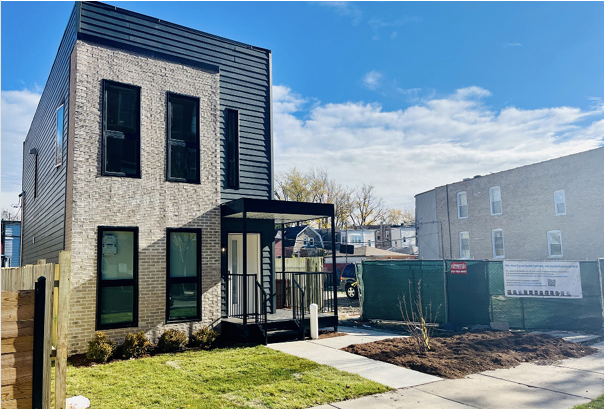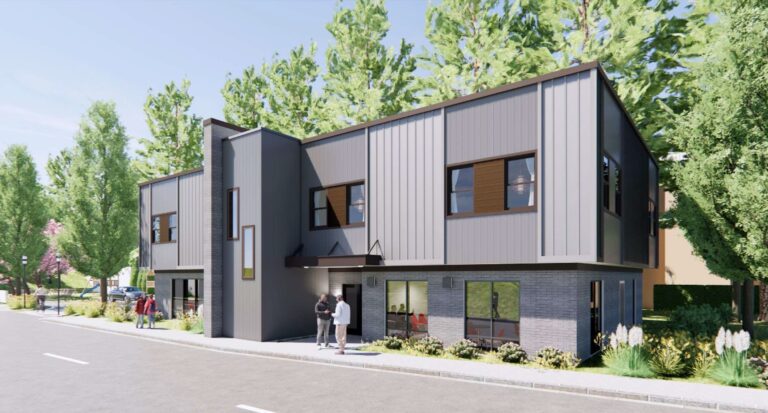Beyond Traditional Giving: How Place-Based Philanthropy Catalyzes Housing Solutions
AUTHORS: A.J. Herrmann and Chanell Hasty
Additional contributions from Chelsy Alfaro at the Housing Authority of the City of Los Angeles, Mark Stuart at the San Diego Foundation, and from National Housing Crisis Task Force members: Frank Fernandez, Marisa Novara and Lourdes Castro Ramírez
Key Points
- Place-based philanthropy can serve as a powerful tool to support housing production and affordability by catalyzing resources, convening key stakeholders, and coordinating strategic planning and partnership efforts within specific geographic areas.
- Place-based philanthropy can deploy large amounts of funding through program related investments (PRIs) and through more traditional giving.
- These investments can support the construction of more homes, experiment with new ways to build housing, and offer better services to residents.
Place-based philanthropy can serve as a powerful tool to support housing production and affordability by catalyzing resources, convening key stakeholders across multiple sectors, and coordinating strategic efforts within specific geographic areas. In many cities, community foundations and other place-based philanthropies are activating and focusing efforts to address the unique challenges and opportunities within their local housing ecosystem, and leading initiatives to launch programs that boost housing supply and affordability. In some cases, they are also directing impact investments into housing production and preservation that generate positive, measurable social or environmental impact alongside financial return.
As a leader in housing production support, the Community Foundation for Greater Atlanta (CFGA) expects to leverage its investments to create or preserve 5,000 affordable units in a five-year period between 2022-2026. San Diego Foundation similarly aims to develop 1,000 units annually through 2034 through its San Diego Housing Fund. A national effort to launch and support similar programs and investment funds could catalyze the creation of at least tens of thousands of units annually.
The Challenge This Tool Solves
The affordable housing ecosystem at the local level is diffuse and often disorganized, making it difficult for stakeholders to broadly assess community needs and coordinate housing production and preservation efforts. Most regions lack a centralized process to match projects in need of additional capital with potential funders, forcing developers to take a piecemeal approach to assembling the capital stacks for worthwhile projects and leaving many opportunities unidentified or abandoned. Moreover, there is significant need for patient, flexible, and affordable capital for acquisition and predevelopment costs, as well as capacity-building for nonprofit and undercapitalized private developers, to build and maintain a strong project pipeline.
Community foundations and other place-based philanthropies can help address these challenges by forming the backbone of local coalitions that bring together policymakers, philanthropy, and the private sector. These coalitions can play key roles in evaluating data, engaging community voices, prioritizing critical needs, and developing or supporting comprehensive strategies to address local housing gaps. As aggregators of mission-driven capital, place-based philanthropies can significantly expand housing production and affordability through impact investment funds, traditional grant-making, and partnerships with the public sector. Community foundations in cities and regions across the country are uniquely positioned to leverage both their social and financial capital to meet the urgent needs of the current housing crisis.
Types of Communities That Could Use This Tool
More than 900 community foundations operate nationally, covering every state and both urban and rural areas. In almost every geography in the U.S., a place-based funder will be operating and could potentially play a supporting or lead role in addressing the housing crisis as a convener, pilot funder, capital aggregator, or organizer of local coalitions.
Expected Impacts of This Tool
Community foundations nationwide collectively manage more than $110 billion in assets and award more than $14 billion in grants annually. More broadly, U.S.-based philanthropic organizations manage over $1.1 trillion in assets, but only about 5% of those are devoted to impact investments. Increasing the percentage of assets that these organizations devote to housing production and deploy through impact investment funds could unlock billions of dollars to support the creation of tens of thousands of homes annually.
Community foundations are grantmaking public charities that mobilize the assets of past and current donors to improve quality of life and economic stability for residents in defined geographic areas. Affordable housing is a key factor in achieving these objectives, as it provides stability for families, supports workforce retention, and enhances overall individual and community well-being. Notably, workers who are forced to move due to housing insecurity are 22% more likely to lose their jobs within a year, and numerous studies demonstrate connections between high household housing cost burdens and poor health outcomes.
As the costs of land, construction, financing, and maintenance have increased in recent years, projects that build or preserve affordable housing increasingly need additional low-cost capital to be financially feasible. This is particularly true for projects that target affordability for households falling significantly below Area Median Incomes (AMI), such as those targeting households earning less than 80% AMI. In a growing number of higher cost markets, subsidies are needed for projects with rents targeted for affordability at or even slightly above median income (up to 120% AMI).
Recognizing this reality, many community foundations and other place-based philanthropic organizations that emphasize economic mobility and quality of life are increasingly interested in supporting affordable housing and housing production. This includes not only direct grantmaking to nonprofit organizations that develop housing or provide housing counseling and related services but also raising and managing impact investment funds that directly support for-sale or rental housing projects. Additionally, some local funders engage with policymakers, the private sector, and other philanthropic organizations to assess, develop, and manage new collaborative programs that address gaps in local housing ecosystems.
There are over 900 community foundations currently operating in the U.S., the majority of which focus on a regional (metropolitan area or similar) footprint, with others also operating at a statewide level. Many place-based private philanthropic organizations play similar roles in their communities, such as The James Irvine Foundation in California and the George Kaiser Family Foundation in Tulsa, greatly expanding the pool of potential organizations that could serve as conveners and funders. Yet much of this potential remains untapped: a 2024 study found that U.S. philanthropic organizations hold total endowment assets valued at over $1.1 trillion, though only 5% of philanthropic foundations invest any of their endowments for impact.


Local Philanthropy as Catalyzer, Convener, and Deployer
Community foundations and other place-based philanthropy can play critical roles in supporting housing production, preservation, and affordability in their geographic areas through four main avenues.
Defining and Prioritizing
Place-based funders can serve as initial catalysts to help regions identify the scale and scope of their housing challenges, as well as gaps or deficiencies in their regional housing ecosystems. Specific actions could include funding a market analysis or needs assessment of the local housing market, convening a group of civic (public, private, and philanthropic) leaders to evaluate the housing market, and developing strategic plans for bolstering housing production. Atlanta and Omaha are both examples of geographic regions where philanthropy played critical roles in developing strategic plans for addressing the housing crisis.
Ongoing Convening and Organizing
Local philanthropy can be essential to “setting the table” for longer term collaboration around housing policy and production. Housing markets are inherently regional, meaning no single local government entity can coordinate housing production for a broader metro area. Furthermore, the short-term tenure and competing daily demands of elected o cials may not align with the longer-term strategic focus needed to increase housing production and supply, making it critical for nongovernmental actors to deeply engage in implementing long-term housing priorities. Local Foundations have supported ongoing convening and organizing through the funding of intermediaries to coordinate regional strategic plans over the long-term (Atlanta, Omaha) and collective impact efforts that partner with local governments and other philanthropy to coordinate transitional housing and homeless services (Oregon, Chicago).
Piloting New Investment and Program Models
Elected leaders and public officials may hesitate to pilot new programs, particularly due to “NIMBY” constituent concerns and competing budget pressures over the commitment of limited government funds. Private investors, particularly those managing institutional capital, may be reluctant to invest in projects they view as risky (e.g., investing in historically disinvested neighborhoods with high loan-to-value and large appraisal gaps). Philanthropy can play a unique role in funding pilot funds, programs, or projects to validate the feasibility of new models for producing or financing housing. Examples include funding to support projects that use innovative building technologies like modular construction (Telluride, Los Angeles), new models for supporting homeownership opportunities (San Diego, Chicago), creating new financing vehicles and products to support affordable developments (Atlanta, Austin) through demonstration models that prove the concept and/or market, and providing seed funding to launch organizations like Community Land Trusts that steward long-term affordability (Western Nevada).
Organizing and Aggregating Long-Term Capital
Many community foundations already serve as capital aggregators for their communities. They pool donations from individual donors, families, and businesses into a unified investment portfolio, achieving economies of scale that enable more effective fund management and greater returns. This provides an opportunity for community foundations to establish and raise impact investment funds focused on housing production. Impact investments through program related investments (PRIs) offer several potential advantages over traditional grants. These include the ability for funds to revolve, exceeding the traditional 5% or similar annual fund threshold for deployment, the possibility of attracting and pooling capital from a wider range of funders (including private investors), and a broader range of investment vehicles through which funds can be deployed (including equity-like instruments). When offering PRIs to nonprofits, foundations can play a role in building up the balance sheet and credit history of a nonprofit, enabling long-term scaling and growth. Foundations can fund administrative, management costs, and seed funding, with most of the investment capital itself coming from private donors. Examples of foundations that have established and are managing large ($100+ million) impact investment funds include the Community Foundation of Greater Atlanta, San Diego Foundation, and Seattle Foundation.
Other organizations like the Scranton Area Community Foundation are beginning to assess how impact investing and philanthropic capital can be most effectively deployed to fill gaps, scale innovative solutions, and support housing and other issue areas relevant to inclusive economic development.
Ideally, place-based philanthropy can act as a flexible, strategic, and long-term convener and catalyst for local efforts in increasing housing production and supply. I can leverage its unique position to take risks in funding new pilots or new investments models that traditional funders may not be willing to take. It can also foster collaboration among the public, private, and philanthropic sectors, serving as a neutral “table-setter” to bring together all the necessary actors in the local housing ecosystem. Philanthropy can also serve as a long-term advocate for systemic changes, an important position in a system where many political actors are constrained by electoral cycles and the desire to differentiate their policies from their predecessors.
Several community foundations have already devoted grant and impact investments to support housing production and affordability. In high-cost, fast growth markets like San Diego, they are launching impact investment funds to support the production of needed workforce housing and partnering with nonprofits to pilot new models of affordable housing development. In cities like Chicago with a stark homeownership gap, they are convening the private and philanthropic sectors to work collaboratively to pilot new pathways to homeownership. In Los Angeles, where public resources are insufficient to meet the huge demand for affordable housing, they are partnering with the city and private sector to launch flexible capital funds that can speed housing production and opportunistically acquire existing market-rate housing that can be converted into affordable rental housing. Finally, in Atlanta, philanthropy is serving as a catalyst for policy change and an aggregator of impact capital, partnering with the city and private foundations to deploy impact investments at scale.
The following case studies provide more information about the activities of philanthropic actors in each of these cities:

Case Study
San Diego Foundation
Beyond Traditional Giving: How Place-Based Philanthropy Catalyzes Housing Solutions
Like many cities, San Diego continues to face significant challenges from the ongoing housing crisis. Nearly 40% of households in the region are cost burdened, and the income needed to afford a down payment on a median-priced home in the city is approaching $200,000.
Read More About San Diego Foundation
Case Study
The Chicago Community Trust
Beyond Traditional Giving: How Place-Based Philanthropy Catalyzes Housing Solutions
Reflecting a national trend, Chicago saw a surge in homelessness in 2024. According to the Chicago Coalition to End Homelessness, approximately 76,375 people experienced homelessness, a 10.4% rise from the previous year.
Read More About The Chicago Community Trust
Case Study
Los Angeles (LA4LA/California Community Foundation)
Beyond Traditional Giving: How Place-Based Philanthropy Catalyzes Housing Solutions
LA4LA is a groundbreaking public-private partnership between local philanthropy, the private sector, and the Office of Los Angeles Mayor Karen Bass.
Read More About Los Angeles (LA4LA/California Community Foundation)
Case Study
Atlanta
Beyond Traditional Giving: How Place-Based Philanthropy Catalyzes Housing Solutions
In Atlanta, nearly 72% of households spend more than 45% of their annual income on housing and transportation, leaving fewer funds for other critical needs and savings.
Read More About AtlantaDiffusion and Scaling of Local Philanthropy
Place-based funders already support housing production and affordability in many jurisdictions nationwide. What is needed now are national efforts to scale and multiply the impact of these scattered initiatives. Concentrated advocacy, education, and technical assistance could encourage dozens of philanthropic organizations to launch new housing initiatives or expand their current housing work for greater impact.
Specific ideas for enabling place-based philanthropy to expand its ability to convene, catalyze policy change, and deploy impact capital to spur housing production include:
- Working with intermediaries such as the Community Foundation Opportunity Network (CFON) and Mission Investors Exchange to spread awareness of how place-based philanthropy can support housing production, showcasing promising case studies and practices from across the country.
- Supporting technical assistance targeted at local community foundations ready to engage in housing, particularly in places where local political leaders are also committed to and engaged in implementing necessary policy and changes, such as the other ideas outlined in the Task Force’s State and Local Action Plan.
- Educating private foundations about the potential of housing-focused impact investment vehicles. CFGA served as both a supplier and aggregator of capital from other local placebased funders, we expect that Community Foundations and other place-based philanthropy will play a similar role in many other communities.
- Creating model fund prospectuses and investment evaluation criteria that can be replicated and widely disseminated.
